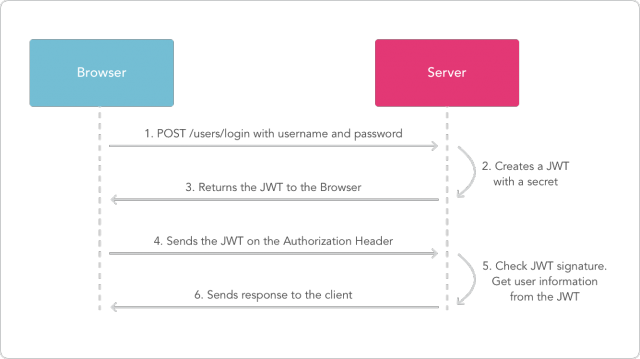Go与Json-Web-Token
JWT是一种用于双方之间传递安全信息的简洁的、URL安全的表述性声明规范。JWT作为一个开放的标准( RFC 7519 ),定义了一种简洁的,自包含的方法用于通信双方之间以Json对象的形式安全的传递信息。因为数字签名的存在,这些信息是可信的,JWT可以使用HMAC算法或者是RSA的公私秘钥对进行签名。
- 简洁(Compact) : 可以通过URL,POST参数或者在HTTP header发送,因为数据量小,传输速度也很快
- 自包含(Self-contained) :负载中包含了所有用户所需要的信息,避免了多次查询数据库
JWT的主要应用场景
- 身份认证在这种场景下,一旦用户完成了登陆,在接下来的每个请求中包含JWT,可以用来验证用户身份以及对路由,服务和资源的访问权限进行验证。由于它的开销非常小,可以轻松的在不同域名的系统中传递,所有目前在单点登录(SSO)中比较广泛的使用了该技术。
- 信息交换在通信的双方之间使用JWT对数据进行编码是一种非常安全的方式,由于它的信息是经过签名的,可以确保发送者发送的信息是没有经过伪造的。
- 前后端分离是一个很有趣的议题,它不仅仅是指前后端工程师之间的相互独立的合作分工方式,更是前后端之间开发模式与交互模式的模块化、解耦化。计算机世界的经验告诉我们,对于复杂的事物,模块化总是好的,无论是后端API开发中越来越成为规范的 RESTful API 风格,还是Web前端越来越多的模板、框架(参见 MVC,MVP 和 MVVM 的图示 ),包括移动应用中前后端天然分离的特质,都证实了前后端分离的重要性与必要性(更生动的细节与实例说明可以参看赫门分享的主题 淘宝前后端分离实践 )。实现前后端分离,对于后端开发人员来说是一件很幸福的事情,因为不需要再考虑怎样在HTML中套入数据,只关心数据逻辑的处理;而前端则需要承担接收数据之后界面呈现、用户交互、数据传递等所有任务。虽然这看起来加重了前端的工作量,但实际上有越来越多丰富多样的前端框架可供选择,这让前端开发变得越来越结构化、系统化,前端工程师也不再只是“套版的”。
JWT的结构
JWT包含了使用 . 分隔的三部分:
- Header 头部
- Payload 负载
- Signature 签名
其结构看起来是这样的
xxxxx.yyyyy.zzzzz
Header
在header中通常包含了两部分:token类型和采用的加密算法。
{ "alg": "HS256", "typ": "JWT" } 接下来对这部分内容使用 Base64Url 编码组成了JWT结构的第一部分。
Payload
Token的第二部分是负载,它包含了claim, Claim是一些实体(通常指的用户)的状态和额外的元数据,有三种类型的claim: reserved , public 和 private .
- Reserved claims : 这些claim是JWT预先定义的,在JWT中并不会强制使用它们,而是推荐使用,常用的有
iss(签发者),exp(过期时间戳),sub(面向的用户),aud(接收方),iat(签发时间)。 - Public claims :根据需要定义自己的字段,注意应该避免冲突
- Private claims :这些是自定义的字段,可以用来在双方之间交换信息
负载使用的例子:
{ "sub": "1234567890", "name": "John Doe", "admin": true } 上述的负载需要经过 Base64Url 编码后作为JWT结构的第二部分。
Signature
创建签名需要使用编码后的header和payload以及一个秘钥,使用header中指定签名算法进行签名。例如如果希望使用HMAC SHA256算法,那么签名应该使用下列方式创建:
HMACSHA256( base64UrlEncode(header) + "." + base64UrlEncode(payload), secret)
签名用于验证消息的发送者以及消息是没有经过篡改的。
完整的JWT
JWT格式的输出是以 . 分隔的三段Base64编码,与SAML等基于XML的标准相比,JWT在HTTP和HTML环境中更容易传递。
下列的JWT展示了一个完整的JWT格式,它拼接了之前的Header, Payload以及秘钥签名:

如何使用JWT?
在身份鉴定的实现中,传统方法是在服务端存储一个session,给客户端返回一个cookie,而使用JWT之后,当用户使用它的认证信息登陆系统之后,会返回给用户一个JWT,用户只需要本地保存该token(通常使用local storage,也可以使用cookie)即可。
当用户希望访问一个受保护的路由或者资源的时候,通常应该在 Authorization 头部使用 Bearer 模式添加JWT,其内容看起来是下面这样:
Authorization: Bearer <token>
因为用户的状态在服务端的内存中是不存储的,所以这是一种 无状态 的认证机制。服务端的保护路由将会检查请求头 Authorization 中的JWT信息,如果合法,则允许用户的行为。由于JWT是自包含的,因此减少了需要查询数据库的需要。
JWT的这些特性使得我们可以完全依赖其无状态的特性提供数据API服务,甚至是创建一个下载流服务。因为JWT并不使用Cookie的,所以你可以使用任何域名提供你的API服务而不需要担心跨域资源共享问题(CORS)。
下面的序列图展示了该过程:

为什么要使用JWT?
相比XML格式,JSON更加简洁,编码之后更小,这使得JWT比SAML更加简洁,更加适合在HTML和HTTP环境中传递。
在安全性方面,SWT只能够使用HMAC算法和共享的对称秘钥进行签名,而JWT和SAML token则可以使用X.509认证的公私秘钥对进行签名。与简单的JSON相比,XML和XML数字签名会引入复杂的安全漏洞。
因为JSON可以直接映射为对象,在大多数编程语言中都提供了JSON解析器,而XML则没有这么自然的文档-对象映射关系,这就使得使用JWT比SAML更方便。
创建一个Go web项目:
首先新建一个auth.go
//auth.go package main import "net/http" funchomePage(reshttp.ResponseWriter, req *http.Request){ res.Write([]byte("Home Page")) } funcmain(){ http.HandleFunc("/", homePage) http.ListenAndServe(":8080", nil) } 设置 TOKEN
gogetgithub.com/dgrijalva/jwt-go
创建请求
type MyCustomClaims struct { // This will hold a users username after authenticating. // Ignore `json:"username"` it's required by JSON Usernamestring `json:"username"` // This will hold claims that are recommended having (Expiration, issuer) jwt.StandardClaims } 创建Handle设置客户端cookie
http.HandleFunc("/setToken", setToken) funcsetToken(reshttp.ResponseWriter, req *http.Request) { // Expires the token and cookie in 24 hours expireToken := time.Now().Add(time.Hour * 24).Unix() expireCookie := time.Now().Add(time.Hour * 24) // We'll manually assign the claims but in production you'd insert values from a database claims := MyCustomClaims { "myusername", jwt.StandardClaims { ExpiresAt: expireToken, Issuer: "example.com", }, } // Create the token using your claims token := jwt.NewWithClaims(jwt.SigningMethodHS256, claims) // Signs the token with a secret. signedToken, _ := token.SignedString([]byte("secret")) // This cookie will store the token on the client side cookie := http.Cookie{Name: "Auth", Value: signedToken, Expires: expireCookie, HttpOnly: true} http.SetCookie(res, &cookie) // Redirect the user to his profile http.Redirect(res, req, "/profile", 301) } 创建验证中间件
中间件可以在http请求前执行
// Middleware to protect private pages funcvalidate(protectedPagehttp.HandlerFunc) http.HandlerFunc { return http.HandlerFunc(func(reshttp.ResponseWriter, req *http.Request){ //Validate the token and if it passes call the protected handler below. protectedPage(res, req) }) } 首先,让我们确定一个cookie
// Middleware to protect private pages funcvalidate(protectedPagehttp.HandlerFunc) http.HandlerFunc { return http.HandlerFunc(func(reshttp.ResponseWriter, req *http.Request){ // If no Auth cookie is set then return a 404 not found cookie, err := req.Cookie("Auth") if err != nil { http.NotFound(res, req) return } //Validate the token and if it passes call the protected handler below. protectedPage(res, req) }) } 从 cookie 中提取token
// Middleware to protect private pages funcvalidate(protectedPagehttp.HandlerFunc) http.HandlerFunc { return http.HandlerFunc(func(reshttp.ResponseWriter, req *http.Request){ // If no Auth cookie is set then return a 404 not found cookie, err := req.Cookie("Auth") if err != nil { http.NotFound(res, req) return } // Cookies concatenate the key/value. Remove the Auth= part splitCookie := strings.Split(cookie.String(), "Auth=") //Validate the token and if it passes call the protected handler below. protectedPage(res, req) }) } 验证token
// Middleware to protect private pages funcvalidate(protectedPagehttp.HandlerFunc) http.HandlerFunc { return http.HandlerFunc(func(reshttp.ResponseWriter, req *http.Request){ // If no Auth cookie is set then return a 404 not found cookie, err := req.Cookie("Auth") if err != nil { http.NotFound(res, req) return } // The token is concatenated with its key Auth=token // We remove the Auth= part by splitting the cookie in two splitCookie := strings.Split(cookie.String(), "Auth=") // Parse, validate and return a token. token, err := jwt.ParseWithClaims(splitCookie[1], &MyCustomClaims{}, func(token *jwt.Token) (interface{}, error){ // Prevents a known exploit if _, ok := token.Method.(*jwt.SigningMethodHMAC); !ok{ return nil, fmt.Errorf("Unexpected signing method %v", token.Header["alg"]) } return []byte("secret"), nil }) protectedPage(res, req) }) } 我们使用 gorilla/context 作为项目的context
gogetgithub.com/gorilla/context
// Middleware to protect private pages funcvalidate(protectedPagehttp.HandlerFunc) http.HandlerFunc { return http.HandlerFunc(func(reshttp.ResponseWriter, req *http.Request){ // If no Auth cookie is set then return a 404 not found cookie, err := req.Cookie("Auth") if err != nil { http.NotFound(res, req) return } // The token is concatenated with its key Auth=token // We remove the Auth= part by splitting the cookie in two splitCookie := strings.Split(cookie.String(), "Auth=") // Parse, validate and return a token. token, err := jwt.ParseWithClaims(splitCookie[1], &MyCustomClaims{}, func(token *jwt.Token) (interface{}, error){ // Prevents a known exploit if _, ok := token.Method.(*jwt.SigningMethodHMAC); !ok{ return nil, fmt.Errorf("Unexpected signing method %v", token.Header["alg"]) } return []byte("secret"), nil }) // Validate the token and save the token's claims to a context if claims, ok := token.Claims.(*MyCustomClaims); ok && token.Valid { context.Set(req, "Claims", claims) } else { http.NotFound(res, req) return } // If everything is valid then call the original protected handler protectedPage(res, req) }) } 创建个人详情页
这个页面只通过token验证的才能访问
funcprofile(reshttp.ResponseWriter, req *http.Request){ claims := context.Get(req, "Claims").(*MyCustomClaims) res.Write([]byte(claims.Username)) context.Clear(req) } Demo 完成 !!!
下面是完整的代码
package main import "github.com/dgrijalva/jwt-go" import "github.com/gorilla/context" import "net/http" import "fmt" import "strings" import "time" type MyCustomClaims struct { Usernamestring `json:"username"` jwt.StandardClaims } funcsetToken(reshttp.ResponseWriter, req *http.Request) { expireToken := time.Now().Add(time.Hour * 24).Unix() expireCookie := time.Now().Add(time.Hour * 24) claims := MyCustomClaims { "myusername", jwt.StandardClaims { ExpiresAt: expireToken, Issuer: "example.com", }, } token := jwt.NewWithClaims(jwt.SigningMethodHS256, claims) signedToken, _ := token.SignedString([]byte("secret")) cookie := http.Cookie{Name: "Auth", Value: signedToken, Expires: expireCookie, HttpOnly: true} http.SetCookie(res, &cookie) http.Redirect(res, req, "/profile", 301) } funcvalidate(protectedPagehttp.HandlerFunc) http.HandlerFunc { return http.HandlerFunc(func(reshttp.ResponseWriter, req *http.Request){ cookie, err := req.Cookie("Auth") if err != nil { http.NotFound(res, req) return } splitCookie := strings.Split(cookie.String(), "Auth=") token, err := jwt.ParseWithClaims(splitCookie[1], &MyCustomClaims{}, func(token *jwt.Token) (interface{}, error){ if _, ok := token.Method.(*jwt.SigningMethodHMAC); !ok{ return nil, fmt.Errorf("Unexpected signing method %v", token.Header["alg"]) } return []byte("secret"), nil }) if claims, ok := token.Claims.(*MyCustomClaims); ok && token.Valid { context.Set(req, "Claims", claims) } else { http.NotFound(res, req) return } protectedPage(res, req) }) } funcprofile(reshttp.ResponseWriter, req *http.Request){ claims := context.Get(req, "Claims").(*MyCustomClaims) res.Write([]byte(claims.Username)) context.Clear(req) } funchomePage(reshttp.ResponseWriter, req *http.Request){ res.Write([]byte("Home Page")) } funcmain(){ http.HandleFunc("/profile", validate(profile)) http.HandleFunc("/setToken", setToken) http.HandleFunc("/", homePage) http.ListenAndServe(":8080", nil) } 参考文献:
https://jwt.io/introduction/
https://dinosaurscode.xyz/go/2016/06/17/golang-jwt-authentication/
Go与Json-Web-Token











![[HBLOG]公众号](https://www.liuhaihua.cn/img/qrcode_gzh.jpg)

